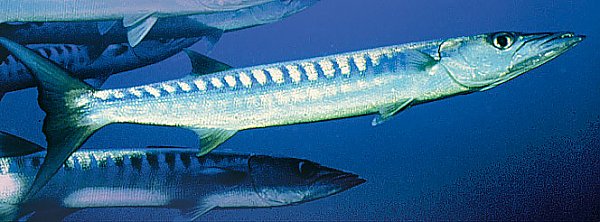California Barracuda
Sphyraena argentea

Photographed in their habitat, the Aquarium's Blue Cavern. Credit: © Aquarium of the Pacific
SPECIES IN DETAIL
California Barracuda
Sphyraena argentea
CONSERVATION STATUS: Safe for Now
CLIMATE CHANGE: Not Applicable
At the Aquarium
California barracuda are found in the Blue Cavern exhibit in the Southern California/Baja Gallery.
Geographic Distribution
Kodiak Islands, Alaska to Cape San Lucas, Baja California, Mexico
Habitat
Barracuda prefer coastal areas near reefs or kelp, but have been found in waters as deep as 37 meters (120 ft). Young are found in shallows. Barracuda are migratory and probably adapt to temperature variations by moving north in spring and summer.
Physical Characteristics
California barracuda have long, slender, almost round bodies. They have a large mouth with canine-like teeth. Their lower jaw projects beyond a sharply pointed snout. They have two dorsal fins that are small and widely spaced. The dorsal side of these fish is grayish-black with a bluish tinge and the ventral sides and belly are silvery or white. The tail is a yellowish color. Females have a charcoal black edge on the pelvic and anal fins. The same fins of males are edged in olive or yellow.
Size
California barracuda average 89 cm (35 in) in length, but can reach up to 122 cm (48 in.) Those weighing over 4.5 kg (10 lbs) are usually females.
Diet
The primary prey of these fish is anchovies and other small fishes such as sardines, young mackerel, and grunion.
Behavior
Barracuda often pump their jaws in order to move water past their gills. Although this behavior may look threatening, California barracuda are typically non-aggressive and will swim away when approached. California barracuda are schooling fish.
Longevity
Barracuda can live up to 12 years.
Conservation
California barracuda are not on the IUCN Red List. Researchers believe that populations of California barracuda are stable, perhaps due to their substantial egg production (300,000 to 400,000 per season).
Predators of barracuda include such birds as bald eagles and terns. They are small commercial fisheries for barracuda in which gillnets, trolling and hook and line methods are used. They are a popular target of sport fishers.
SPECIES IN DETAIL | Print full entry
California Barracuda
Sphyraena argentea
CONSERVATION STATUS: Safe for Now
CLIMATE CHANGE: Not Applicable
California barracuda are found in the Blue Cavern exhibit in the Southern California/Baja Gallery.
Kodiak Islands, Alaska to Cape San Lucas, Baja California, Mexico
Barracuda prefer coastal areas near reefs or kelp, but have been found in waters as deep as 37 meters (120 ft). Young are found in shallows. Barracuda are migratory and probably adapt to temperature variations by moving north in spring and summer.
California barracuda have long, slender, almost round bodies. They have a large mouth with canine-like teeth. Their lower jaw projects beyond a sharply pointed snout. They have two dorsal fins that are small and widely spaced. The dorsal side of these fish is grayish-black with a bluish tinge and the ventral sides and belly are silvery or white. The tail is a yellowish color. Females have a charcoal black edge on the pelvic and anal fins. The same fins of males are edged in olive or yellow.
California barracuda average 89 cm (35 in) in length, but can reach up to 122 cm (48 in.) Those weighing over 4.5 kg (10 lbs) are usually females.
The primary prey of these fish is anchovies and other small fishes such as sardines, young mackerel, and grunion.
Barracuda often pump their jaws in order to move water past their gills. Although this behavior may look threatening, California barracuda are typically non-aggressive and will swim away when approached. California barracuda are schooling fish.
Barracuda can live up to 12 years.
California barracuda are not on the IUCN Red List. Researchers believe that populations of California barracuda are stable, perhaps due to their substantial egg production (300,000 to 400,000 per season).
Predators of barracuda include such birds as bald eagles and terns. They are small commercial fisheries for barracuda in which gillnets, trolling and hook and line methods are used. They are a popular target of sport fishers.

